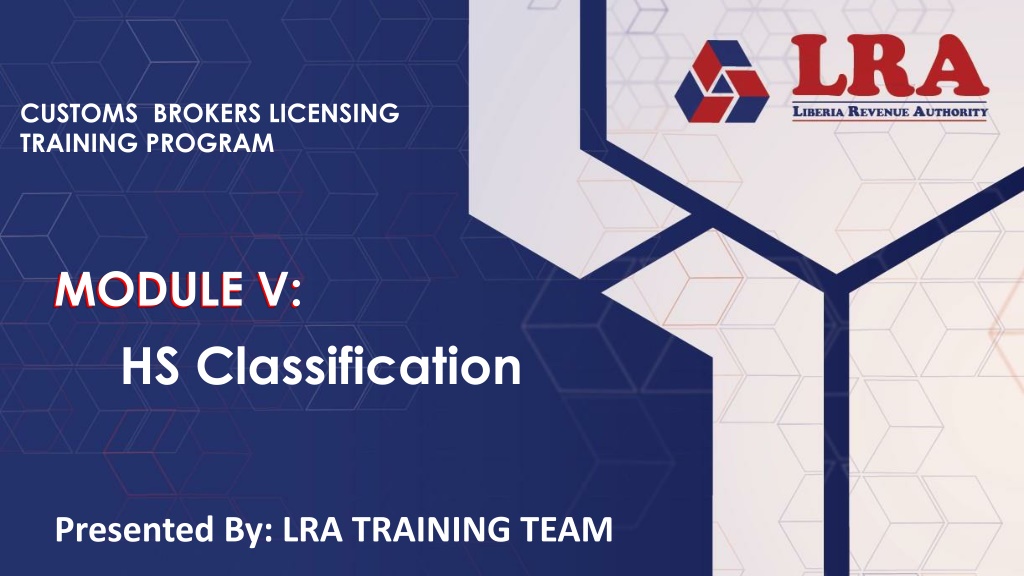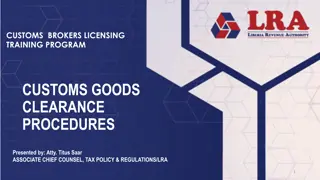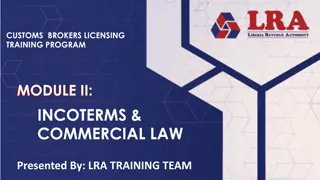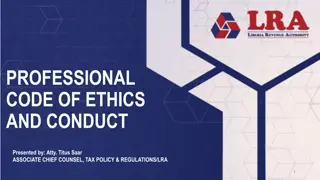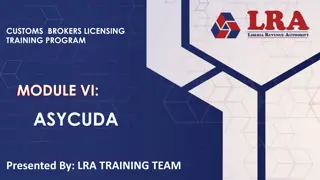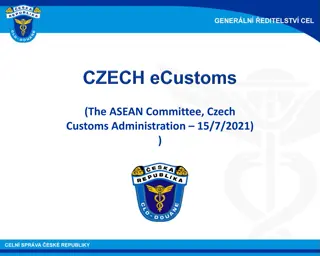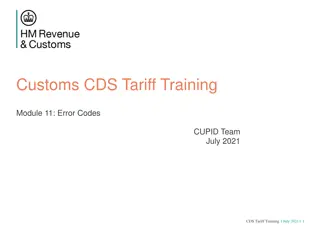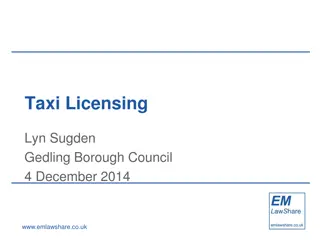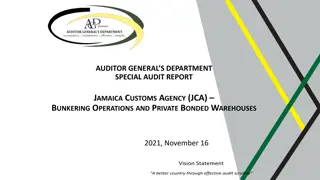Customs Brokers Licensing Training Program Module V: HS Classification Overview
Enhance your knowledge and skills in customs brokerage to pass the licensing uniform examination successfully. This module covers the evolution of customs nomenclature, reasons for tariff classification, HS structure, and more essential topics. Participants will learn to define technical terms, compare tariff structures, apply GIRs correctly, and much more to become efficient customs brokers. Don't miss out on this opportunity to excel in the field of customs brokerage.
Download Presentation

Please find below an Image/Link to download the presentation.
The content on the website is provided AS IS for your information and personal use only. It may not be sold, licensed, or shared on other websites without obtaining consent from the author. Download presentation by click this link. If you encounter any issues during the download, it is possible that the publisher has removed the file from their server.
E N D
Presentation Transcript
CUSTOMS BROKERS LICENSING TRAINING PROGRAM MODULE V: HS Classification Presented By: LRA TRAINING TEAM
INTRODUCTION The participants in this course are entreated to do their utmost best to enhance their knowledge and skills to make them efficient and active participants and to contribute effectively to the conduct of the class session. This may lead to a successful pass in the Customs Brokers Licensing uniform examination. 2
INTRODUCTION On the other hand, participants who may not assert themselves proficiently in this module, could stand the risk of not passing the uniform examination and may fail to be licensed to practice as professional Customs broker. 3
OUTLINE 1. Module objectives 2. Background to Tariff Classification Evolution 3. Overview of the HS structure 4. The structure of the HS Liberia 2012 HS vs. CET 5. Overview of the General Interpretative Rules (GIRS) 6. The meaning of classification 7. Why classify using HS? 8. How to us the HS
Module Objectives At the end of this module, participants should be able to: Define technical terms and Latin phrases used in the customs nomenclature Outline the evolution of customs nomenclature State the reasons for tariff classification Identify the uses of the Harmonized System Outline the structure of the Harmonized System 4
Module Objectives Cont. At the end of this module, participants should be able to: Compare and contrast Liberia 2012 HS Tariff Structure to that of the CET Identify the concept/principles of HS classification Outline the legal basis for tariff classification Identify relevant documents required for proper classification Correctly apply the GIRs to classify traded goods 5
SESSION I EVOLUTION OF THE HS NOMENCLATURE
Session Objectives At the end of this session, participants should be able to: Out the important stage (dates) to the evolution of the HS Define key terminologies and Latin phrases use in the HS nomenclature Outline the goals and reasons for HS classification Outline the uses of the HS 6
The Evolution of Customs Nomenclature The Harmonized System took over 100 years to design; beginning in 1853 with the International Statistical Nomenclature (ISN) up to the Harmonized System (HS) in 1988. ISN 1853 GN 1931 BTN 1950 CCCN 1974 HS 1988 7
Definition of key terms and Latin phrases Internationaltrade is an exchange of goods between two or more countries. CET means common external tariff. Mutatis mutandis means with the necessary changes Inter alia means among other things Prima facie means at first sight Etc. =etcetera means and the others/and so forth 10
Definition of key terms and Latin phrases Cont. Nomenclature means a systematic naming, or enumerating of all goods found in international trade along with international rules and interpretations. Customstariff as used herein refers to a systematic classification of goods entering the international trade for national interests together with rates of duties. Classification means a process of arriving at a particular heading or subheading of a commodity entering the international trade. 9
Overview of the HS Core specifics and structure of HS is universal Member countries eligible to define specific detail items and assign applicable rates of duty to any required category Goals: Systematic classification of all goods Uniformity in classification Internationally accepted customs language 9
Reasons for Tariff Classification Systematic Classification of all goods Uniform Classification of all goods To have common Customs language To ensure simplification and certainty 9
Uses of Harmonized System Basis for customs tariff Collection of international trade statistics Rules of origin Collection of government revenue Trade negotiations (e.g. the WTO schedule of tariff concessions) Transport tariffs and statistics Monitoring prohibited and restricted goods 11
SESSION II HS STRUCTURE
Session Objectives At the end of this session, participants will be able to provide information regarding: Structure of the HS Nomenclature Compare and contrast HS and CET Structures Distinguish b/w legal and non-legal text of the HS Outline basic principles underlying HS structure 12
The Structure of the HS A six-digit nomenclature First four digits equal heading First six digits equal sub-heading 17
HS Structure HS Structure LIB 2012 HS vs. CET LIB 2012 HS vs. CET CET Liberia 2012 HS Rate (Advalorem) 0% 1.5% 2.5% 5% 7.5% 10% 11% 15% 20% 25% 45% 50% Frequency 2 9 473 1930 870 440 99 989 607 311 1 57 Rate Description 0% Essential goods 5% Basic raw materials, capital goods and specific inputs 10% Intermediate goods 20% Finished goods (ready for consumption) 35% Selected finished industrial products with regional capacity or potentials
The HS Structure Diagrammatic Illustration
HS Structure Cont. International (HS) Code Positions Chapter 1 & 2 Heading 3 & 4 Subheading 5 & 6
Basic Principles of the HS Structure Level of processing of the goods Origin of the goods Chemical composition of the goods Material make-up of the goods Functions of the goods
Text of the HS Legal Non-Legal GIRs index Section Notes Section Titles Chapter Notes Chapter Titles Subheading Notes Subchapter Titles Heading Explanatory Notes Subheading Compendium of classification opinion
SESSION III OVERVIEW AND APPLICATION OF THE GIRS
Session Objectives At the end of this session, participants will be able to: provide information on General Interpretative Rules (GIRS) Outline the principles of tariff classification List the steps to using the HS Correctly apply the GIRs to classify goods
Principles of tariff classification A commodity can be classified either by: Terms of heading Notes to sections, chapters or subheadings General Interpretative Rules
General Observation Goods in the HS are grouped in two broad categories: Goods which the earth is endowed with. E.g. minerals, animals, plant water, etc. Goods which are man-made e.g. TVs, motor vehicles, the list is endless because of change in technologies
General ObservationCont. Goods under chapters 1 to 83 are generally classified according to material of manufacture Under chapter 84 to 96 are generally classified to function
Overview of GIRs GIRs are designed to ensure that a given product is always classified in the same heading and subheading with the exclusion of any other heading meriting consideration. In fact, they illustrate and provide step-by-step basis for classification of goods in the harmonized system.
Summary of GIRs Six Rules Must be applied in numerical order esp. GIRS (1-4) Rules 1-4 classify actual goods Rule 5; packing and packaging Rule 6; classify at 6 digit sub-heading level
Usage of GIRs Use terms of the headings Use terms of the section and chapters notes NOTE: Most goods are classified to their direct heading without recourse to rules 2-4
How do we use the HS Read explanatory notes Refer to index Find headings that appear to describe the goods Find the most specific headings Check section and chapter notes Apply GIRS
Important Qs Before classification: What is it? What material or substance is it made of? What are its function or use? In what form is it usually imported? Is this the only possible classification?
Example of Classification Laptop Computer Identity: machine material: various (above Chap. 83) Function: Data processing Possible section: XVI Possible Chap. 84 Heading 84.74
Example of classification Cont. FORK OF WOOD Identity: Article of wood Material: wood (below Chap. 83) Function: Tableware/cutlery Possible Section: IX Possible Chap. 44 Heading 44.19
Self-Testing Questions Classify the following articles: 1. Chair made of wood 2. Radio 3. umbrella 4. Playing cards 5. Plastic toys
Self-Testing Questions Classify the following articles: 1. Chair made of plastic 2. flour 3. Biscuit 4. Silk & cotton men shirt 5. Plastic toys 6. Alum. Zinc 7. Eye glasses
